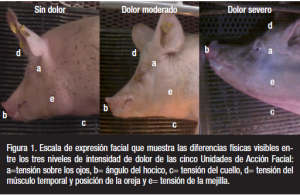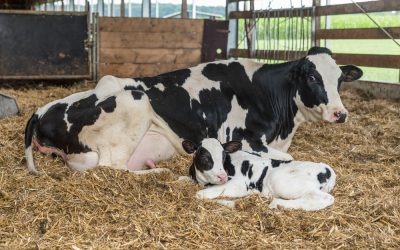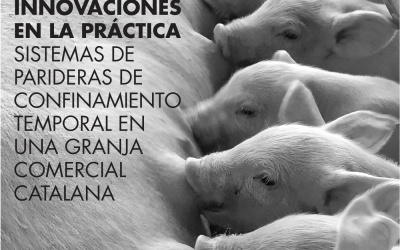E.Navarro, E.Mainau, D.Temple, P. Llonch, X.Manteca
More information
Download PDF Technical document
Pain is a sensory and emotional experience that has negative effects on animal welfare, directly affecting farm production items. There are many reasons why pigs can suffer from pain: routine farm management, such as tail-docking and castration, diseases, injuries and physiological events such as farrowing. Nowadays, pain measurement in farm animals is very complex, and it continues to be an important issue in veterinary and biomedical research.
FARROWING IS A PAINFUL EVENT
It is generally accepted that farrowing is a physiological painful event that all production sows experience a minimum of once in their lives. This pain can be even more intense if the sow suffers any problem, like dystocia (for example, exaggeratedly long parturitions). In consequence, pain associated with farrowing represents a potential welfare concern, and the consequences of pain can cause economic losses. For instance, pain at farrowing can impair recovery post-farrowing by reducing sow food and water intake and reducing milk let-down. This contributes to a reduced growth and an increased piglet mortality.
It has been shown that primiparous sows generally have more painful parturitions than multiparous ones, associated with the lack of experience of the dams at first parturition and the fact that normally they have longer parturitions. It is suggested that, during early farrowing, primiparous sows experience, on average, greater sensory pain than do multiparous sows. However, as farrowing progresses, these differences seem to be less pronounced. And after farrowing, recent research has concluded that multiparous sows experience more pain from uterine activity than do primiparous ones. It could be that uterine contractions after the last piglet is born (when the uterus contracts and returns to its pre-gestation size) are more painful for multiparous as compared with primiparous sows due to the loss in uterine tone.
PAIN AROUND FARROWING: RECOGNITION AND EVALUATION
Pain recognition is an important issue that scientists are working on. Ideally, pain in animals should be studied by combining different types of indicators, including productive, physiological and behavioural ones, which are not always that simple to validate and assess.
Productive indicators are used in many studies. Contrary to what is thought, in many cases, pain can be quantified through productive indicators. In sows, when they experience long or extremely painful farrowings, they usually show a deficient maternal behaviour. Altered maternal behaviour can result in higher neonatal mortality and a lower number of piglet-suckling events, which can also reduce piglet growth.
Physiological indicators are not specific enough when we study pain around farrowing. It has been shown that around farrowing, the sow increases cardiac frequency, respiratory rates and rectal temperature, due to the pain experienced. These indicators are not really specific, because there are other factors, such as stress or hormonal changes during parturition, that can modify it, and it could disturb the results´ interpretation.
Behavioural indicators are considered the most valid and specific parameter when pain in farm animals is studied. Normally, they are carried out using non-invasive tools. As we will see detailed below, these sows’ indicators at farrowing are based on postural changes, specific pain indicators and, recently, facial expressions:
• Postural changes. High levels of pain during farrowing related to dystocic parturitions induce more postural changes during farrowing. In consequence, piglet suckling periods decrease, increasing piglet mortality. Instead, there are some studies that describe that an increased number of postural changes three days after farrowing means a recovery of the sow, increasing her water consumption and, consequently, her milk production, thus guaranteeing further piglet growth.
• Specific pain indicators. It has been seen that pain indicators incidence around farrowing is related to the pain suffered by the sow, these indicators being more frequent during farrowing than during post-farrowing. The corporal pain indicators that have been studied around farrowing and showed a good correlation with the pain suffered by the sow are: pulling the back leg forward, trembling, back-arching, pawing and tail-flicking. Tail-flicking associated with imminent birth.
• Facial expressions. Facial expressions are the newest behavioural pain indicators studied in sows. A recent study proposes a facial expression scale based on five Facial Action Units (FAUs) using farrowing as a model of pain in sows. These FAUs are: tension above eyes, snout angle, neck tension, temporal tension and ear position, and cheek tension. Changes in facial expression seem to be a useful tool to assess pain in sows and are categorized into three pain-intensity degrees: painless (19 days post-farrowing), moderate pain (moment between two piglets´ expulsion) and severe pain (moment of piglet expulsion) (Figure 1).

MELOXICAM AS A FARROWING PAIN RELIEF
Meloxicam is a very well-used non-steroidal anti-inflammatory drug (NSAID) licenced in Europe for the control of pain associated with castration in piglets, as well as for locomotor disorders in pigs and for supportive therapy together with antibiotics in the treatment of mastitis metritis agalactia syndrome (MMA) in sows.
An important issue when we speak about health problems in reproductive females is that the consequences not only affect them, but they also concern their piglets. Difficult farrowing in sows is associated with increased postural changes during farrowing and early post-farrowing, spending more time lying sternally rather than lying laterally, and directly affecting the piglets’ milk-consumption and growth. Early colostrum intake is crucial for the piglets’ immunity development and survival because piglets are born with limited energy and are devoid of immune protection.
Recently, NSAIDs have proved to help sows in recovery from a painful post-partum situation. They also have been demonstrated to decrease the mortality rate at weaning. Meloxicam is a NSAID that, administered to healthy sows around farrowing, improves post-farrowing sow recovery, enhancing piglet growth at weaning, especially in piglets with low body weight at birth. Meloxicam also shows benefits in immune transfer. The administration of meloxicam orally in multiparous sows, at the beginning of farrowing, has been demonstrated to increase the concentration of immunoglobulins and cytokines in sow colostrum, improving both humoral and cellular immune response in piglets.
SUMMARY
Farrowing is a painful event that all production sows must experience a minimum of once in their lives. Several pain indicators have been studied in order to recognize parturitions with unacceptable pain. Nowadays, behavioural indicators are considered to be the most valid and specific parameter to assess pain in farm animals. Recently, a Pain Facial Expression scale has been developed to identify and evaluate pain during farrowing. Meloxicam is a good pain relief medicine that decreases sows’ pain and increases piglets’ immunity and body weight at weaning.
REFERENCES
• Ison SH, Jarvis S, Hall SA, Ashworth CJ, Rutherford KMD 2018. Periparturient behavior and physiology: Further insight into the farrowing process for primiparous and multiparous sows. Frontiers in Veterinary Science 5. https://doi.org/10.3389/fvets.2018.00122
• Ison SH, Jarvis S, Rutherford KMD 2016. The identification of potential behavioural indicators of pain in periparturient sows. Reserch in Veterinary Science 109, 114–120.
https://doi.org/10.1016/j.rvsc.2016.10.002
• Mainau E, Temple D, Manteca X 2016. Experimental study on the effect of oral meloxicam administration in sows on pre-weaning mortality and growth and immunoglobulin G transfer to piglets. Preventive Veterinary Medicine https://doi.org/10.1016/j.prevetmed.2016.01.032
• Navarro E, Mainau E, Manteca X 2020. Development of a Facial Expression Scale Using Farrowing as a Model of Pain in Sows. Animals 10: 2113.
https://doi.org/10.3390/ani10112113
• Navarro E, Mainau E, De Miguel R, Temple D, Salas M, Manteca X 2021. Oral meloxicam administration in sows at farrowing and its effects on piglet immunity transfer and growth. Frontiers in Veterinary Science 8:574250. https://doi.org/10.3389/fvets.2021.574250



